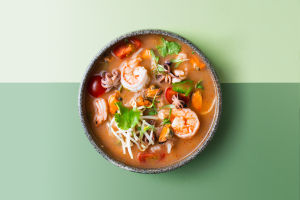Tea bags are more than just a quick way to enjoy a cup of tea. With a little creativity, tea bags can be used in various recipes and culinary experiences that go far beyond a simple brew.
Here’s a guide for Lykkers and all tea enthusiasts on unique ways to incorporate tea bags into recipes, along with some restaurant recommendations where tea-infused creations shine.
1. Cooking with Tea Bags
Tea bags can add a subtle depth of flavor to dishes, transforming everyday recipes into something special.
Here are some easy ways to start:
Tea-Infused Rice or Grains: Add a tea bag (green or jasmine tea works well) to boiling water before cooking rice, quinoa, or couscous. The tea releases gentle, aromatic notes that complement a variety of meals. Simply remove the tea bag before serving, and enjoy a lightly flavored dish that pairs well with stir-fried vegetables or grilled chicken.
Broths and Soups: Add an herbal tea bag (like chamomile or peppermint) while simmering soups for a new layer of flavor. Chamomile, for example, adds a mild floral note that pairs well with creamy or vegetable-based soups.
Tea-Smoked Proteins: For those looking to try something more advanced, tea-smoked chicken or tofu is a flavorful option. Black tea bags work best for this method. Combine tea bags with rice and sugar in a wok, then place a rack above the mix. Place marinated chicken or tofu on the rack, cover tightly, and heat until the tea mixture begins to smoke, infusing the protein with a
2. Tea-Infused Desserts
Tea bags can also work wonders in desserts, adding depth and complexity to sweet treats.
Tea-Infused Ice Cream or Pudding: Infuse black tea or chai tea bags into warm milk before mixing it with other ingredients for ice cream, custards, or puddings. The tea adds a rich, comforting flavor, especially in desserts like vanilla or caramel pudding.
Tea-Infused Syrups: Brew a strong tea using 2-3 tea bags and mix it with sugar to create a tea-flavored syrup. This syrup is perfect for drizzling over pancakes, waffles, or even fruit. Try using fruity teas like berry or peach flavors for a unique twist.
Matcha or Green Tea Cookies: While traditional matcha powder is often used, a green tea bag can also be opened and added directly to cookie dough or cake batter. This adds a gentle green tea taste that pairs well with white chocolate or almond-based desserts.
3. Refreshing Tea-Based Drinks (Non-Alcoholic)
Tea bags can be used to make refreshing cold drinks, offering a healthier, flavor-packed alternative to sugary beverages.
Iced Tea Lemonade: Brew black or herbal tea bags, then chill the tea and mix it with fresh lemon juice and a hint of honey for a refreshing iced tea lemonade. Serve with ice and garnish with mint leaves.
Tea-Based Smoothies: Use chilled green tea as a base for smoothies. Blend with fruits like mango, banana, or berries for a nutrient-packed drink with an extra boost from green tea's antioxidants.
Fruit-Infused Cold Brew: For a twist on cold-brewed tea, place a tea bag in a pitcher of water along with slices of fruit like orange or strawberry. Let it steep overnight in the fridge, creating a naturally flavored cold brew perfect for hot days.
Tea-Infused Restaurant Recommendations
For those who want to try tea-infused creations without cooking at home, several restaurants and cafes offer tea-inspired dishes and drinks:
Alice’s Tea Cup (New York) – Known for its whimsical atmosphere and tea-inspired menu, this tea room serves items like tea-marinated meats and tea-infused desserts. Prices range from $10 for tea treats to $30 for a full meal.
Tea Drunk (Los Angeles) – A cozy spot that celebrates tea, Tea Drunk offers unique tea pairings with light dishes. Their tea-inspired desserts are a must-try, especially the matcha-based sweets, with prices around $15-$20.
The Urban Tea Merchant (Vancouver) – This tea lounge serves tea-infused lunches and high tea experiences. Their popular jasmine-infused rice and tea-smoked salmon bring out the elegance of tea in savory dishes. Expect prices around $25 for lunch options.
Historical Background: The Invention of the Tea Bag
Interestingly, the tea bag was invented in the early 20th century by accident. Thomas Sullivan, a New York tea merchant, sent out samples of tea in silk pouches. Unaware that these were samples, customers used them to brew tea directly in hot water, giving rise to the concept of the tea bag we use today. This simple innovation has since transformed how tea is enjoyed worldwide.
Tips for Choosing the Right Tea Bags
Quality Over Quantity: For cooking or infusing, use high-quality tea bags with real leaves rather than dust or fannings.
Match Flavors: Select flavors that complement your dish. Green tea works well with seafood, black tea with meats, and fruity or floral teas for desserts.
Experiment: Different brands and blends can yield various flavors, so feel free to experiment with your favorite types of tea.
In summary
Tea bags are far more versatile than they may appear at first glance. From infusing dishes to creating unique desserts and drinks, tea can add a new dimension to your culinary adventures. With this guide, Lykkers and all tea lovers can unlock the hidden potential of tea bags, bringing creativity and flavor into the kitchen in unexpected ways.


